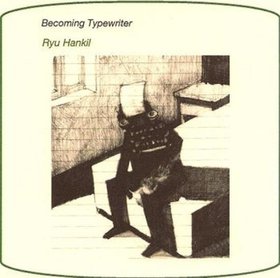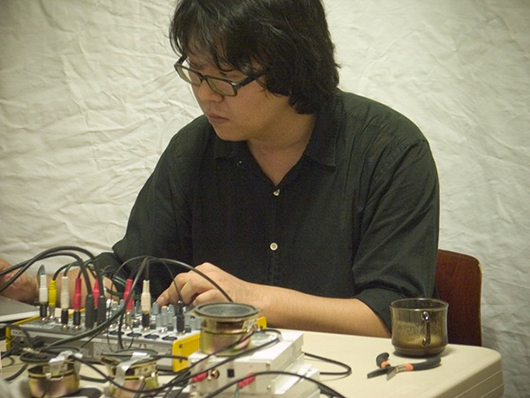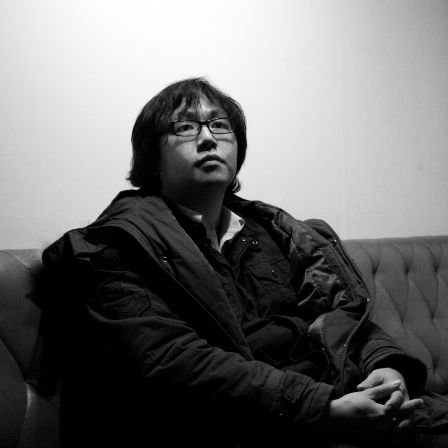Tags
Ryu Hankil – The Sound of one hand Typing
Ryu Hankil’s solo improvisation at Echoraum from Balloon & Needle on Vimeo.
I attended a seminar on Kafka and Philosophy on Thursday (which I will write more about in posts this week) which culminated in an amazing hour-long lecture by Henry Sussman, Visiting Professor of Germanic Languages from Yale university. I found the day enormously stimulating, but one of the key points of Henry Sussman’s talk (The Calculable, the Incalculable, and the Rest: Kafka’s Virtual Environment) was the isometrical relationship between typographical systems within a text that can be explored long after the text has been written. In other words, with what we have learned about (for example) mathematics, we can apply to a writer like Kafka, and find that isomorphic systems live within the text that have always been there, but were previously unknown to us.
This is because of the nature (and Henry Sussman would argue) the incredible importance of writing. He argued that writing goes well beyond the abilities of the writer, because they are tapping into a complexity within “us” that we may not have discovered the language for, but will become obvious when the language has emerged.
Naturally, all through the talk, I was thinking of modern modes of music and the way they have opened literature up for us. I was filled to bursting with ‘awareness’s’ about the isomorphic relationship between sound and writing. This, of course, has been explored by artists for awhile now, but I hadn’t thought of the connection in terms of biology! This opened up a new way of thinking about this relationship for me.
Then, on Richard’s blog this week, this little gem shows up.
Ryu Hankil is one of the most interesting musicians from the scene that arose on South Korea. Coming from the indie pop and electro music, he concentrated on improvised music after a collaboration with korean noise duo Astronoise and attending a live concert by Otomo Yoshihide, Axel Dörner, Sachiko M and Taku Unami. Hankil uses clockworks as an instrument. He is interested in finding musical structures and so on in the vibration of objects.
Ryu Hankil – “I Am In Plague” (excerpt) from serdzoid on Vimeo.
This is a new release on the Manuallabel where Hankil is exploring his music with the typewriter a little deeper. According to Richard Pinells blog, the way this works is thus:
This particular release is a joint creation with the writer Lo wie.
The way this release works, (and I think also the other two, though I’ve not investigated them fully yet) is that Lo wie has contributed a text, which Hankil has then sat down and literally typed out on his old cast iron typewriter. Now, as I have written about here before, the typewriter is set up in such a way that depressing certain keys causes it to set of various other electroacoustic activity- little motors set in motion, buzzes, rattles etc, with electric circuits completed each time certain metal parts touch, so setting things off into action. So, Hankil has taken the text and, as far as I can tell, has just set about typing it, so that the precise shape and form of the music is dictated by the sequence of keys needed to tap out Lo wie’s work.
The text is something of a tribute/homage to Samuel Beckett. It consists of an almost repeated paragraph that feels like it is looping back on itself, which it does, but changes each time, so pulling out lines over and over in a thoroughly Beckettian manner, insistent, urgent, maybe obsessed. The opening line in each part of the text is often “I am in my mother’s room”, carefully taken front he first line of Beckett’s Molloy. The writing is very nice, imparting a particular sense of seemingly pointless, hammering repetition which is then extended further into the music produced from typing it up.
An Interesting thing I have since learned about Ryu Hankil is that he chose the typewriter as his next instrument before he found one he could use and before he had any idea how to perform with one. This period led to a disc called Becoming Typewriter, that I have been playing this week.
When he did get his typewriter going, he began performing some live shows in order to explore it as an instrument. You can see some short videos of these above. The idea is to move the typewriter away from its original purpose, move it musically in a cycle so that it comes back to its origins in literature and writing again. The typewriter is used as a typewriter in the new releases, theoretically concluding its life as an instrument. There is still another section to add to the cycle before its completion.
Musical works are temporal and sonic objects that achieve their meaning through duration, just as objects in the visual arts achieve theirs through space. Without significant duration, musical works are but sound with limited aural attendance or aesthetic experience. Sound artists have drawn our attention to the sonic artifacts of daily existence through the composing and arranging of such sounds within pieces of greater duration than mere momentary sonic intrusions. (Quote taken from William Ashlines article on Vague Terrain blog)
According to Sussman, The Angel of History no longer stares longingly into the past. The past is no longer an origin, a time more authentic than others, because a greater degree of intimacy once prevailed there. It is rather, a relative position along an indifferent continuum – one might say tedium – of time.
The literary implication of this slight shift are multifaceted: In the conception of literature characters, the role of surrogation diminishes in favour of functionality. Characters do not so much embody subjects, real or imagined, as they perform functions within language and throughout the range of philosophical, sociopolitical and psychological economies. In his short prose, Kafka had already experimented with treating characters as the hypothetical agents of logical and mathematical word problems, a practise subsequently exploited above all by Italo Calvino.
Given this interesting perspective on the isomorphic relationships between typographical systems, Ryu Hankil‘s work takes on the broader context of giving the literature a chance at a kind of temporal freedom, in that the music frees it (possibly) from a grounding in its continuum. Here is another way of reading Beckett, just as mathematics provides us with another way of reading Kafka.
I’ll explore this much further, in subsequent posts.





Pingback: Saturday 11th February | The Watchful Ear
Pingback: Ryu Hankil – Description for Other things « Lisa Thatcher
Pingback: The Natural Conservatorium for Wise Women – Absurdism after the female. (Theatre Review) | Lisa Thatcher